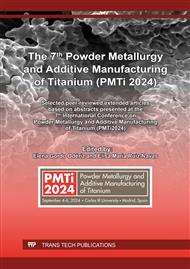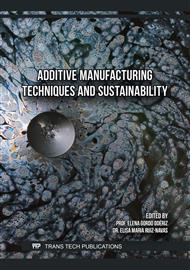p.3
p.13
p.23
p.29
p.41
p.49
p.59
p.69
Ti and Co-Cr-Mo Alloy Dissimilar Surface Modification Obtained by Laser Surface Alloying / Additive Manufacturing
Abstract:
Additive manufacturing has significantly advanced in the last two decades and can now produce various mechanical components. However, some limitations exist, such as the size and surface finish of the part. This work reports preliminary results of joining dissimilar metals or alloys by additive manufacturing inspired by welding dissimilar joints. Single laser tracks were produced by laser surface alloying, simulating laser powder bed fusion, using homemade additive manufacturing equipment composed of a computer numerically controlled table and a ytterbium-doped fiber laser operating inside an Argon chamber. Mo, Co, and Cr powders were used to obtain additively manufactured layers on a Ti substrate, aiming to produce a gradient from the Ti to the Co-Cr-Mo alloy. The results showed that increasing the heat input increased the dilution of Ti in the Co-Cr-Mo modified layer and decreased the hardness and the formation of cracks. Obtaining an intermediate layer of Mo reduced the dilution in the upper layers. It increased hardness by 629 ± 20 HV, indicating the feasibility of manufacturing multi-material pieces made of commercially pure Ti with an intermediate layer in Mo and a Co-Cr-Mo alloy. Such pieces aim for future application in hip implants, in which, in addition to the more flexible Ti stem, a femoral head with properties close to the Co-Cr-Mo alloy for excellent wear resistance.
Info:
Periodical:
Pages:
23-28
Citation:
Online since:
March 2025
Keywords:
Price:
Сopyright:
© 2025 Trans Tech Publications Ltd. All Rights Reserved
Share:
Citation:



